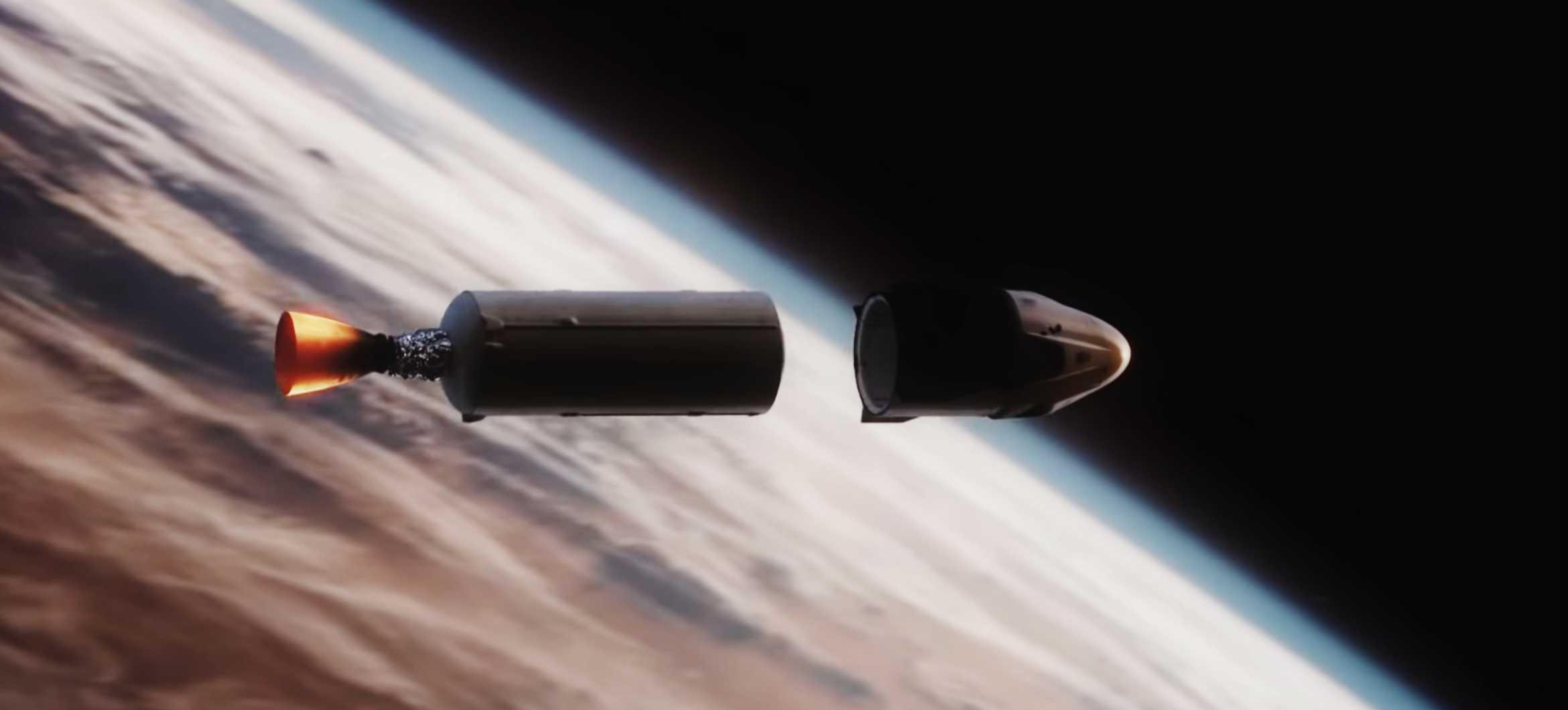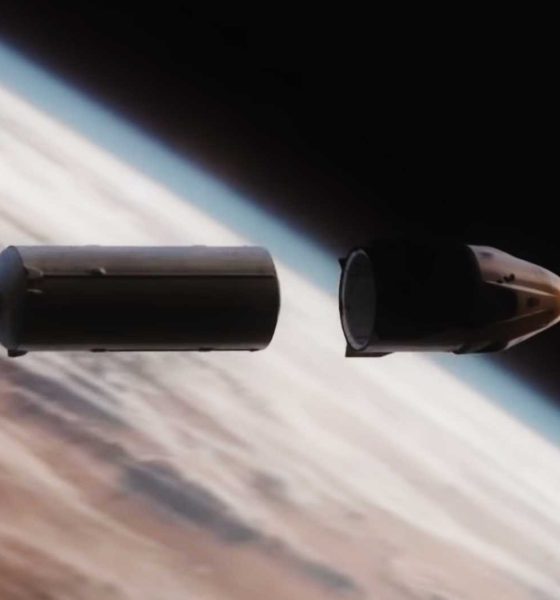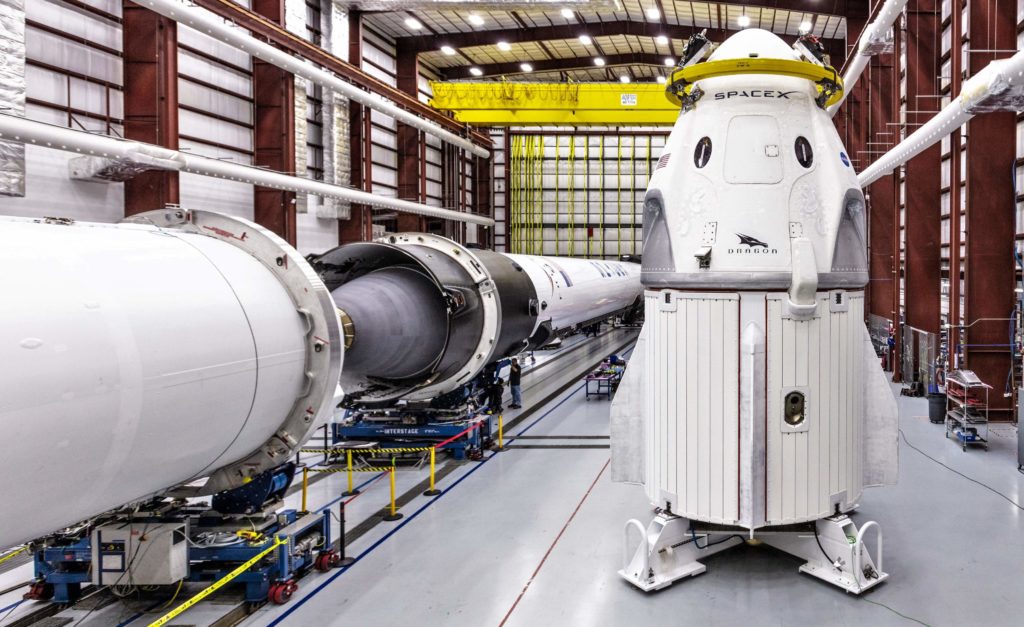

News
SpaceX rapidly tests, ships Falcon 9 second stage for next NASA astronaut launch
SpaceX has shipped, tested, and delivered the new Falcon 9 upper stage tasked with carrying the company’s next Crew Dragon astronauts to orbit as early as October 30th.
Offering rare insight into the kind of timelines and margins SpaceX operates on for even its most important missions, a Falcon upper stage bearing NASA’s ‘worm’ logo and ‘meatball’ insignia was spotted by a local resident and photographer on October 2nd. Thus far, the only SpaceX rockets that have flown with NASA iconography are those supporting Crew Dragon launches, making them a dead giveaway for Crew Dragon launch hardware.
After Demo-2, SpaceX’s May 2020 astronaut launch debut, the company moved those decals from Falcon 9’s booster – liable to fly any number of non-NASA missions later in life – to each NASA crew mission’s expendable Falcon second stage (S2). Since then, Crew-1 (November 2020) and Crew-2 (April 2021) have both launched with NASA logos on their second stages and Crew-3 now looks set to continue that tradition.
Thanks to the watchful eye of local resident turned SpaceX fan Reagan Beck, it was actually possible to identify Crew-3’s Falcon 9 upper stage as soon as it was spotted at the company’s McGregor, TX development and testing facilities on October 2nd. While there was technically a tiny chance that it could be for one of several upcoming NASA spacecraft launches or even for Crew Dragon’s April 2022 Crew-4 mission, the likeliest destination by far for the NASA-branded Falcon S2 was Crew-3.
Due partially to the fact that Falcon booster qualification testing typically takes McGregor at least two or so weeks but mainly to the seemingly razor-thin schedule margins it would imply, there was some understandable skepticism that the upper stage was bound to launch Crew-3 just four weeks after it was first spotted. Moreso, Crew Dragon typically rolls out to the launch pad on Falcon 9 at least 5-7 days before launch to allow extra time for an integrated static fire, final checkouts, and a ‘dry dress’ practice runs for each mission’s crew.
Further, even after completing static fire qualification testing in McGregor, Crew-3’s Falcon stage would still need to be packaged up, transported more than a thousand miles by road, carefully unpackaged at a SpaceX launch site or hangar, outfitted with a Merlin Vacuum nozzle extension, installed on the mission’s Falcon 9 booster, and mated to Crew Dragon itself before that pad rollout can occur. In other words, rather than Crew-3’s exact October 30th launch date, the mission’s upper stage would likely need to arrive at SpaceX’s Kennedy Space Center (KSC) Pad 39A launch facilities at least 9-10 days before launch.
Realistically, that means that from the moment the NASA-branded upper stage first spotted on a McGregor test stand, it had maybe two weeks to complete qualification testing and ship out to Pad 39A. With practically no context, that seemed like a stretch at the time – particularly for a single-engine Falcon second stage explicitly tasked with safely delivering four astronauts to orbit. In reality, McGregor’s Falcon S2 testing is apparently far faster than booster testing and the presumed Crew-3 stage seemingly passed qualification testing and vacated the test stand less than five days after it was installed.
In theory, that left the McGregor team about a week to complete post-test inspections, clean the interior of its propellant tanks, and prepare the stage for the last leg of its journey to Florida. SpaceX seemingly managed that without issue and a new Falcon upper stage potentially meant for Crew-3 was spotted in Florida just a few miles away from a SpaceX launch site on October 14th.
However, per additional photos and reports from Reagan, McGregor’s second stage test team has been incredibly busy over the last month or so. Prior to the Crew-3 stage’s arrival, another second stage completed qualification testing between September 21st and 28th. Crew-3’s S2 was installed on October 2nd and removed by the 7th. Wasting no time, another second stage was installed on the same stand on October 10th and apparently completed testing by the 13th – equivalent to a new upper stage qualified every week. Even if the Falcon stage that arrived at Cape Canaveral on October 14th isn’t Crew-3’s, then, Crew-3’s can’t be far behind.

Ultimately, SpaceX appears to be testing and shipping one of two integral Falcon 9 stages for a crucial, schedule-sensitive NASA astronaut launch with schedule margins measured in hours or single-digit days. That’s a far cry from competitors Arianespace and ULA and even NASA itself, which generally deliver flight hardware months in advance. Eleven years since Falcon 9’s launch debut, every Falcon second stage that has made it through stage separation – 127 of 127 – has successfully ignited its Merlin Vacuum engine one or several times and delivered its payload(s) to the correct orbit(s). Well over half of those successful launches were completed in the last three and a half years – and with the same Falcon 9 upper stage variant now routinely tasked with carrying astronauts to orbit.
In other words, delivering a NASA Crew mission’s Falcon second stage less than two weeks before the assembled rocket is scheduled to roll out to the launch pad may seem a tad reckless, it’s more likely that it’s evidence of SpaceX’s second stage build/test teams and facilities operating as an incredibly reliable, well-oiled machine.

News
Tesla FSD fleet is nearing 7 billion total miles, including 2.5 billion city miles
As can be seen on Tesla’s official FSD webpage, vehicles equipped with the system have now navigated over 6.99 billion miles.

Tesla’s Full Self-Driving (Supervised) fleet is closing in on almost 7 billion total miles driven, as per data posted by the company on its official FSD webpage.
These figures hint at the massive scale of data fueling Tesla’s rapid FSD improvements, which have been quite notable as of late.
FSD mileage milestones
As can be seen on Tesla’s official FSD webpage, vehicles equipped with the system have now navigated over 6.99 billion miles. Tesla owner and avid FSD tester Whole Mars Catalog also shared a screenshot indicating that from the nearly 7 billion miles traveled by the FSD fleet, more than 2.5 billion miles were driven inside cities.
City miles are particularly valuable for complex urban scenarios like unprotected turns, pedestrian interactions, and traffic lights. This is also the difference-maker for FSD, as only complex solutions, such as Waymo’s self-driving taxis, operate similarly on inner-city streets. And even then, incidents such as the San Francisco blackouts have proven challenging for sensor-rich vehicles like Waymos.
Tesla’s data edge
Tesla has a number of advantages in the autonomous vehicle sector, one of which is the size of its fleet and the number of vehicles training FSD on real-world roads. Tesla’s nearly 7 billion FSD miles then allow the company to roll out updates that make its vehicles behave like they are being driven by experienced drivers, even if they are operating on their own.
So notable are Tesla’s improvements to FSD that NVIDIA Director of Robotics Jim Fan, after experiencing FSD v14, noted that the system is the first AI that passes what he described as a “Physical Turing Test.”
“Despite knowing exactly how robot learning works, I still find it magical watching the steering wheel turn by itself. First it feels surreal, next it becomes routine. Then, like the smartphone, taking it away actively hurts. This is how humanity gets rewired and glued to god-like technologies,” Fan wrote in a post on X.
News
Tesla starts showing how FSD will change lives in Europe
Local officials tested the system on narrow country roads and were impressed by FSD’s smooth, human-like driving, with some calling the service a game-changer for everyday life in areas that are far from urban centers.

Tesla has launched Europe’s first public shuttle service using Full Self-Driving (Supervised) in the rural Eifelkreis Bitburg-Prüm region of Germany, demonstrating how the technology can restore independence and mobility for people who struggle with limited transport options.
Local officials tested the system on narrow country roads and were impressed by FSD’s smooth, human-like driving, with some calling the service a game-changer for everyday life in areas that are far from urban centers.
Officials see real impact on rural residents
Arzfeld Mayor Johannes Kuhl and District Administrator Andreas Kruppert personally tested the Tesla shuttle service. This allowed them to see just how well FSD navigated winding lanes and rural roads confidently. Kruppert said, “Autonomous driving sounds like science fiction to many, but we simply see here that it works totally well in rural regions too.” Kuhl, for his part, also noted that FSD “feels like a very experienced driver.”
The pilot complements the area’s “Citizen Bus” program, which provides on-demand rides for elderly residents who can no longer drive themselves. Tesla Europe shared a video of a demonstration of the service, highlighting how FSD gives people their freedom back, even in places where public transport is not as prevalent.
What the Ministry for Economic Affairs and Transport says
Rhineland-Palatinate’s Minister Daniela Schmitt supported the project, praising the collaboration that made this “first of its kind in Europe” possible. As per the ministry, the rural rollout for the service shows FSD’s potential beyond major cities, and it delivers tangible benefits like grocery runs, doctor visits, and social connections for isolated residents.
“Reliable and flexible mobility is especially vital in rural areas. With the launch of a shuttle service using self-driving vehicles (FSD supervised) by Tesla in the Eifelkreis Bitburg-Prüm, an innovative pilot project is now getting underway that complements local community bus services. It is the first project of its kind in Europe.
“The result is a real gain for rural mobility: greater accessibility, more flexibility and tangible benefits for everyday life. A strong signal for innovation, cooperation and future-oriented mobility beyond urban centers,” the ministry wrote in a LinkedIn post.
News
Tesla China quietly posts Robotaxi-related job listing
Tesla China is currently seeking a Low Voltage Electrical Engineer to work on circuit board design for the company’s autonomous vehicles.

Tesla has posted a new job listing in Shanghai explicitly tied to its Robotaxi program, fueling speculation that the company is preparing to launch its dedicated autonomous ride-hailing service in China.
As noted in the listing, Tesla China is currently seeking a Low Voltage Electrical Engineer to work on circuit board design for the company’s autonomous vehicles.
Robotaxi-specific role
The listing, which was shared on social media platform X by industry watcher @tslaming, suggested that Tesla China is looking to fill the role urgently. The job listing itself specifically mentions that the person hired for the role will be working on the Low Voltage Hardware team, which would design the circuit boards that would serve as the nervous system of the Robotaxi.
Key tasks for the role, as indicated in the job listing, include collaboration with PCB layout, firmware, mechanical, program management, and validation teams, among other responsibilities. The role is based in Shanghai.
China Robotaxi launch
China represents a massive potential market for robotaxis, with its dense urban centers and supportive policies in select cities. Tesla has limited permission to roll out FSD in the country, though despite this, its vehicles have been hailed as among the best in the market when it comes to autonomous features. So far, at least, it appears that China supports Tesla’s FSD and Robotaxi rollout.
This was hinted at in November, when Tesla brought the Cybercab to the 8th China International Import Expo (CIIE) in Shanghai, marking the first time that the autonomous two-seater was brought to the Asia-Pacific region. The vehicle, despite not having a release date in China, received a significant amount of interest among the event’s attendees.








